Table of contents
Video has become one of the most natural ways for brands to communicate with their audiences. More and more companies – regardless of industry – are using this format not only for promotion, but also to build relationships, explain complex topics or show the „human face” of the business.
Video content marketing is not a trend that will pass in a moment, but a tool that, if used well, can realistically support sales, customer education and brand recognition. However, it’s not about creating random videos, but about planned activities that have meaning and purpose.
In this article you will find specific examples, simple strategies and key benefits of implementing video in marketing communications.
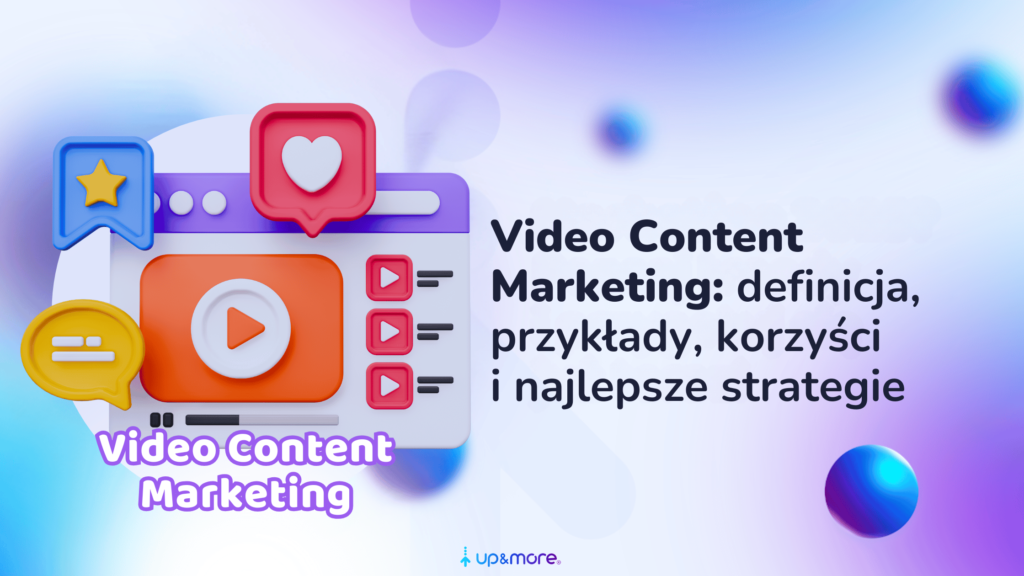
What is video content marketing?
Video content marketing is a strategy that relies on creating and sharing videos that promote a brand, products or services. It is a form of advertising that uses video content to engage audiences, build brand recognition and achieve business goals. This type of content not only conveys valuable information, but also allows you to establish an emotional connection with viewers. Published on platforms such as YouTube, TikTok or Instagram, they can strongly affect emotions and gain viral hit status.
What’s more, video marketing effectively supports key business goals. It attracts new customers, increases sales and builds brand loyalty. However, the key to success lies in the quality and originality of the materials created.
What is the difference between video content marketing and traditional video marketing?
Video content marketing differs from traditional video marketing primarily in its approach to the goal and the way content is created. Content marketing focuses on building relationships with audiences by providing valuable content rather than direct, pushy promotion. These are often educational videos, inspirational stories or engaging tales that capture attention and build trust in the brand.
The differences are also evident in content distribution. In content marketing, it is important to adapt the format to the specifics of the platform – on TikTok or Instagram, short, dynamic clips that quickly grab attention dominate, while YouTube may feature longer, more elaborate materials. Traditional video marketing, on the other hand, relies on classic media such as television, where standard, longer commercial spots with a clear promotional message reign supreme.
The role of authenticity and storytelling is also an important aspect. Modern video marketing often uses user-generated stories or influencers to establish an emotional connection with viewers. In the traditional approach, such elements are used less often, the priority remains sales, and the message usually ends with a direct call to action.
Why is video content marketing important for businesses?
Video content marketing plays a key role in companies’ strategy because it enables them to effectively capture the attention of their audiences and communicate content in a way that is memorable. Video not only helps showcase a product or service, but also builds an emotional connection with viewers through dynamic images and sounds. Telling a story through video makes the message more personal and memorable.
Video content is eagerly watched and shared on social media, significantly expanding its reach. Investing in creative and original clips allows you to stand out from the competition, and a well-executed video can evoke emotions and reactions that other forms of advertising cannot.
- build relationships with customers – video allows you to create engaging stories that bring your brand closer to your audience,
- increase reach on social media – videos are shared more often than other content, increasing visibility,
- induce emotion – dynamic images and sound interact more effectively with viewers,
- present products in an attractive way – video enables you to show the advantages of your offerings in an accessible form,
- stand out in the market – a creative approach to video content builds a unique brand image.
Remember that video content marketing is not just about sales, but about creating lasting relationships with customers through authentic and engaging stories. Bet on quality and originality, and the results will surely exceed your expectations!
How does video content marketing affect business results?
It attracts more visitors and supports achieving higher search engine rankings, which directly translates into business success. Moreover, video content is shared as much as five times more often than static posts, which significantly builds engagement among the audience.
Short clips showcasing products can effectively attract customers and contribute to sales. The use of various forms of video, such as user-generated recordings or practical tutorials, strengthens brand recognition and encourages action. Popular platforms such as YouTube and TikTok further increase social media visibility, leading to more potential customers and increased revenue.
Impact on brand awareness and audience engagement
Video marketing is one of the most powerful tools for building brand awareness and engaging audiences. Videos capture attention and remain in the memory much longer than other forms of media. Studies show that as many as 80% of people remember a brand better after watching a related video. That’s an impressive result that shows just how effective this medium can be.
What makes video so powerful for its audience? Footage showing behind-the-scenes of a company’s operations or interviews with its representatives builds an emotional connection with viewers. On platforms such as Instagram or YouTube, such content boosts trust, while live broadcasts, such as on Facebook, allow longer and more direct contact with viewers. The result? Audience engagement grows rapidly.
Another advantage is the popularity of user-generated content (UGC), especially on platforms such as TikTok and Instagram. The authenticity of these materials encourages interaction – commenting or sharing. In this way, video not only brings a brand closer to its audience, but also significantly increases its social media reach.
The impact of video content marketing on brand awareness and audience engagement is undeniable. That’s why it’s worth using its potential to stand out from the competition and build lasting relationships with customers.
How to measure the effectiveness of video marketing efforts?
The most important indicators are the time a video is viewed and the percentage of viewers who made it to the end, as they show whether the content is engaging. Equally important are interactions, such as likes, comments and shares, which show the level of engagement. Don’t overlook the number of views and the conversion rate, which measures how many viewers took the desired action after watching the video, such as making a purchase or signing up for a newsletter.
To analyze the results, it’s worth using dedicated tools that provide detailed data. Among the most popular solutions are:
- google Analytics – monitors website traffic generated by videos,
- social media platforms – offer data on user reach, views and reactions,
- social listening apps – help understand brand opinions and sentiment based on comments and discussions.
Regular analysis of this data is crucial to success. Not only does it allow you to optimize your strategy on an ongoing basis, but it also allows you to better match your video content to your audience’s preferences and expectations, which directly translates into achieving your goals.
What are the most popular types of video content?
The variety of formats allows you to tailor your content to the needs of different target groups and platforms. So what are the most popular types of video content?
- educational videos and tutorials – provide valuable information, building brand recognition and engaging viewers,
- customer reviews and case studies – increase trust in the company, convincing the undecided to buy,
- webinars and live broadcasts – enable direct contact with the audience, strengthening brand ties,
- short clips (Instagram Reels, TikTok) – win the hearts of younger users, especially Generation Z, generating 35% more responses in the vertical format,
- vlogs, reviews and unboxings – attract viewers on platforms such as YouTube and Facebook, offering authentic content.
Video content that evokes emotion often spreads viral online. Shares and likes increase their reach at no additional cost. The key to success, however, lies in matching the format to the specifics of the platform. LinkedIn, for example, is perfect for B2B communications, while Pinterest inspires visual appeal. The right approach to creating and distributing video content can significantly improve the results of marketing efforts.
Educational and instructional videos
Educational and instructional videos play a key role in video content marketing, as they explain complex issues in an accessible way, making them easier to understand. For example, tutorials or animated explanations allow customers to become more familiar with the products or services offered, effectively dispelling doubts before making a purchase.
This type of content is particularly effective at the initial stage of the sales funnel. They build trust in the brand, emphasizing its professionalism and competence. Additionally, when published on platforms such as YouTube or social media, they capture the attention of the audience and encourage interaction with the company.
Customer testimonials and case studies
Customer testimonials and success stories in video form are a powerful tool in building trust and enhancing content marketing strategies. Such materials not only lend credibility to the brand, but also show real experiences of people who have taken advantage of the offer. For example, a video can illustrate how a product or service helped solve a specific problem, combining emotion with compelling data, such as a 30% increase in revenue after implementing the solution. This allows the content to go straight to the hearts and minds of the audience.
This type of content is especially valuable when a potential customer is considering a purchase. When published on platforms such as YouTube or LinkedIn, they are effective in attracting attention, increasing interest in an offer and helping to convert viewers into customers. More important, however, is to maintain brand authenticity and credibility – it is sincerity that builds lasting relationships with audiences.
Webinars and live broadcasts
Webinars and live broadcasts are tools in video content marketing that enable direct contact with audiences and build lasting relationships with customers. By holding online training sessions or presentations, companies effectively attract attention and engage their audience.
Live broadcasts, available on platforms such as Instagram and YouTube, add authenticity to the message, which significantly boosts viewers’ trust. Real-time product demonstrations and the ability to answer questions immediately make viewers feel closer to the brand, and their engagement increases. Webinars, on the other hand, allow a company to establish itself as an expert by providing content full of practical knowledge.
Platforms such as Facebook and LinkedIn also support marketing goals through live video and online sessions. These tools not only increase brand recognition, but also effectively guide potential customers through the steps of the buying process. Additional features, such as chats or interactive polls, further deepen the interaction with viewers. Interestingly, the time spent on such materials is even 2-3 times longer than on standard recordings.
- building relationships – direct contact with viewers fosters a bond with the brand,
- authenticity of the message – live broadcasts increase trust through spontaneity and real-time interaction,
- expert positioning – webinars provide valuable content, building credibility for the company,
- increased engagement – interactive features, such as chats and surveys, deepen contact with viewers,
- effectiveness in B2B – webinars are a key tool in winning business in this sector.
How to create an effective video content marketing strategy?
To create an effective video content marketing strategy, it’s a good idea to start with a thorough understanding of your target audience. The most important thing is to understand the needs and expectations of your audience and determine the goals of your campaign – whether it’s to build brand recognition or perhaps to educate customers. Video content should be tailored to your audience, offering practical tutorials or inspirational stories, for example. It is important that they fit harmoniously into a broader marketing plan, taking into account the specifics of platforms such as YouTube, TikTok or Instagram.
The next step is to choose the right video formats. Consider what will best appeal to your target audience and what stage of the purchase path they are at. It is important that the production is well planned – a solid script and storyboard are the foundation of any material. Professional editing will give your content the right rhythm, and brevity combined with high quality will increase its appeal. Publishing in popular formats, such as Instagram Reels or YouTube Shorts, can significantly expand your reach.
Don’t forget about search engine optimization. It’s a good idea to include relevant key phrases in your video titles and descriptions, making it easier for users to find your content. Regular analysis of statistics, such as the number of views, viewing time or engagement level, will allow you to assess what is working and what needs improvement. Stay on top of trends, especially on dynamic platforms like TikTok, and flexibly adjust your approach to strengthen your brand image over time and achieve better results in the form of more conversions.
If you want to plan your strategy effectively, pay attention to a few key elements:

The process of planning and producing video content
The process of planning and producing video content is a complex, but extremely important part of an effective strategy. It starts with understanding the needs of the audience and defining the goals of the campaign, which is the foundation of any successful project. Who are the people you are targeting with your message? Do you care about increasing brand recognition, or perhaps increasing sales? The answers to these questions shape the next steps.
The next step is careful preparation. Developing a script and storyboard allows you to determine what you want to show and how. This will give your video clarity and consistency, and get your message exactly where it needs to go.
Then you move on to implementation. When shooting footage or creating animation, remember to take care of the details. High quality production is essential – proper lighting, clear sound and well-chosen backgrounds can significantly increase the value of your content. The format of the footage, adapted to the platform, is also important:
- vertical footage – ideal for TikTok or Instagram,
- horizontal footage – best for YouTube,
- square format – effective for Facebook or LinkedIn posts.
After the footage is finished, it’s time for editing. You assemble the material into a cohesive whole, add graphic elements such as logos or catchy slogans, and a clear call to action (CTA). You publish the finished video on the platforms of your choice according to a set schedule to maximize its reach.
Finally, you analyze the results. You check the number of views, viewing time and audience engagement level. These data are invaluable clues that will help you assess what worked and what is worth improving in the future.
Optimizing video content for SEO
To effectively improve the SEO of your videos, it’s worth focusing on a few important aspects that will help you reach a wider audience and increase engagement.
Start by creating thoughtful titles and descriptions in which you naturally incorporate key phrases. This will give your video a better chance of ranking higher in search results on platforms such as YouTube and Google. Don’t forget about transcriptions – not only do they help algorithms better understand the content of your video, but they also increase accessibility for people with hearing limitations.
Another important step is the appropriate use of tags and metadata. The use of schemas, such as VideoObject Schema, makes it easier for search engines to interpret the material. Thumbnails play an equally important role – an attractive, catchy image can increase click-through rates by as much as 30%, as YouTube statistics show.
Technical aspects that have a direct impact on SEO and user experience should not be overlooked. Here are the elements you should pay attention to:
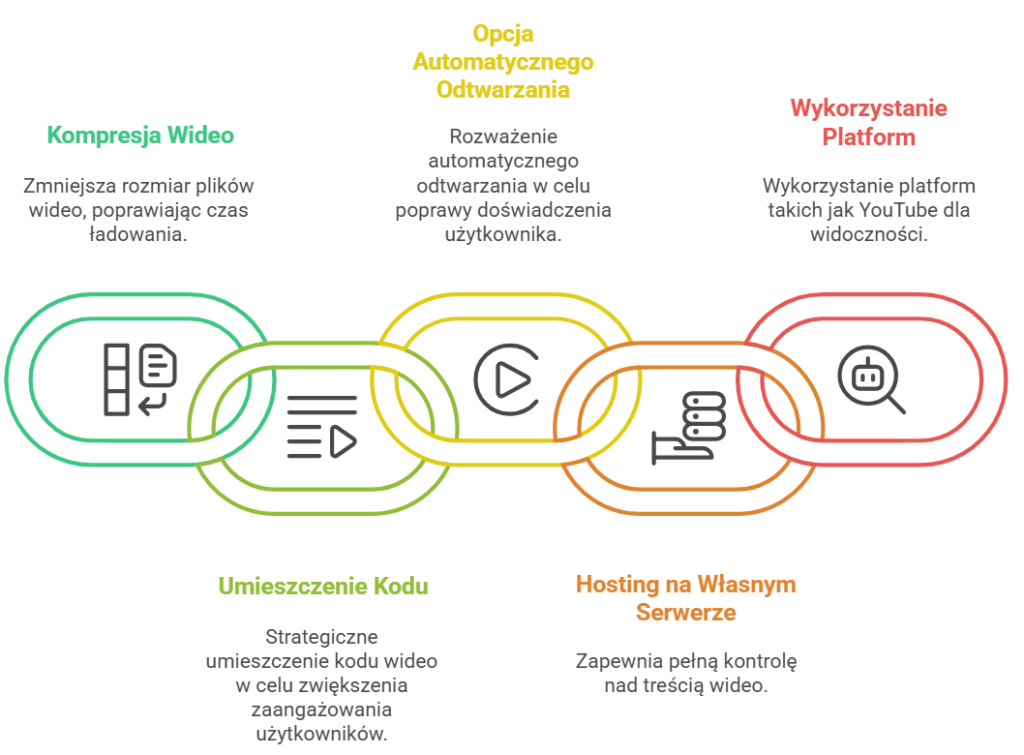
Personalize content by adding captions or creating dynamic, short clips, such as on Instagram Reels. Such actions not only increase reach, but also build brand recognition and capture the attention of your audience.
Frequent challenges and how to deal with them
One of the key aspects of video content marketing is to effectively deal with challenges that may arise at various stages of content creation and distribution. Here’s a look at the most common difficulties and practical ways to overcome them.
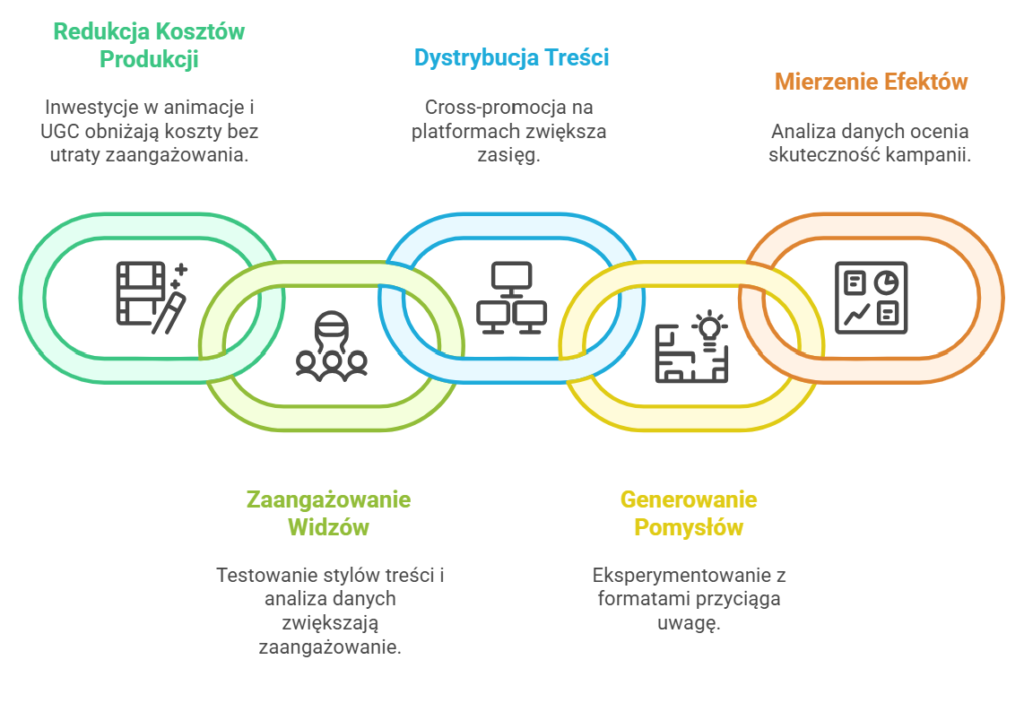
Examples of effective content marketing video campaigns
Effective content marketing video campaigns have the power to capture attention and evoke emotion through their originality. Here are inspiring examples that show how a variety of approaches can build brand recognition and engage audiences.
Examples of successful video content marketing campaigns
- the „Polish Legends” series – a YouTube project that accumulated millions of views, combining emotions with elements of Polish culture, which not only increased brand recognition, but also encouraged viewers to actively engage,
- Dove’s „Real Beauty” campaign – using the art of storytelling, made viewers reflect on the concept of beauty, reaching more than 68 million impressions and building brand authenticity and a strong emotional connection with the audience,
- GoPro in action – the brand focuses on dynamics, presenting its products from the user’s perspective, and the content on Instagram and TikTok is shared by hundreds of thousands of people,
- Red Bull and extreme emotions – combines video with passionate lifestyle, promoting footage of sporting events that attract crowds of fans and highlight the company’s unique character.
These examples prove the importance of creating content in line with brand values and current trends. In addition, precisely worded calls to action can significantly strengthen relationships with audiences, building lasting engagement.
Best Practice Analysis
Analysis of best practices in video content marketing indicates that a key element of success is skillful storytelling, which lends authenticity to the material and builds a bond between the brand and viewers. It is also important to adapt the format to the specifics of the platform – for example, short, vertical videos work well in Instagram Reels or on TikTok, which significantly increases the chances of reaching a wide audience.
Regularly publishing content, both on YouTube and Facebook, allows you to gain the trust of your audience and maintain their interest. It is worth enriching materials with interactive elements, such as polls or clear calls to action (CTAs). The statistics are clear – videos with CTAs generate as much as 38% more clicks! It is no less important to actively respond to comments, which helps build an authentic relationship with viewers. To stay up to date, follow trends – popular tones or challenges on TikTok can effectively enhance your content.
Examples of successful campaigns prove that emotions play a key role in achieving success. Equally important is consistency with the values represented by the brand. Mistakes such as ignoring platform algorithms should be avoided, as this can negatively affect your image. Regular analysis of the effects of activities is essential – pay attention to the number of impressions, viewing time and audience reactions. This will make it easier to align your strategy with your business goals and the needs of your audience.
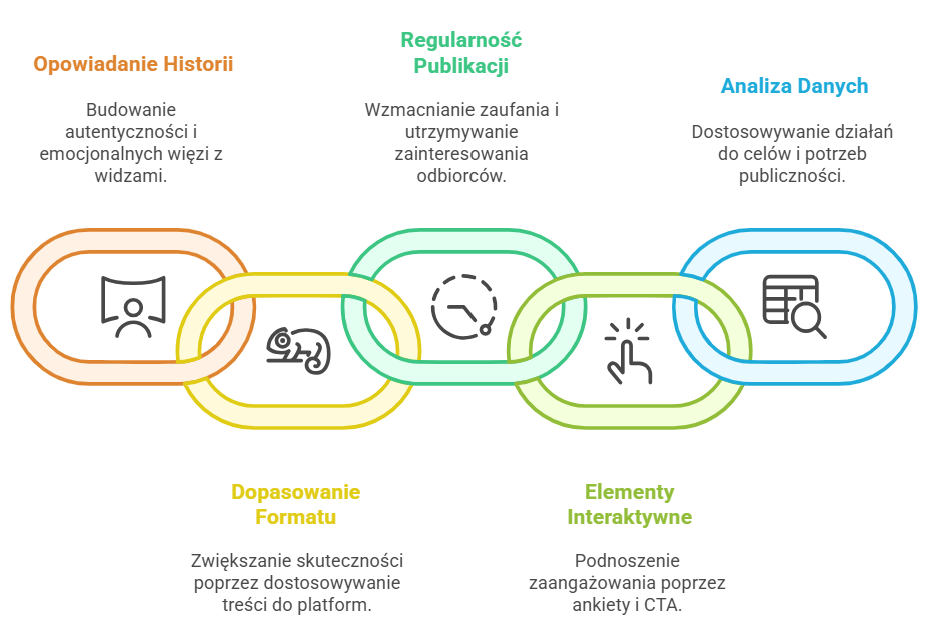
Most important lessons from successful campaigns
The success of a video campaign in content marketing is based on several key elements that are worth considering to achieve the best results. First and foremost, a deep understanding of your audience is fundamental – only by knowing your audience’s needs and expectations can you create content that really speaks to them.
Another important aspect is to skillfully combine education with entertainment. Dynamic, short videos that entertain and teach at the same time attract attention and increase engagement on social media. Equally important is the strategic use of calls to action (CTAs). Placed in the right place and at the right time, they effectively guide audiences through the purchase path, increasing the chances of conversion.
Don’t forget about content optimization. Aligning content with SEO principles and the specifics of platforms such as TikTok or YouTube is important for reach. The video format often determines whether the content will reach a wide audience.
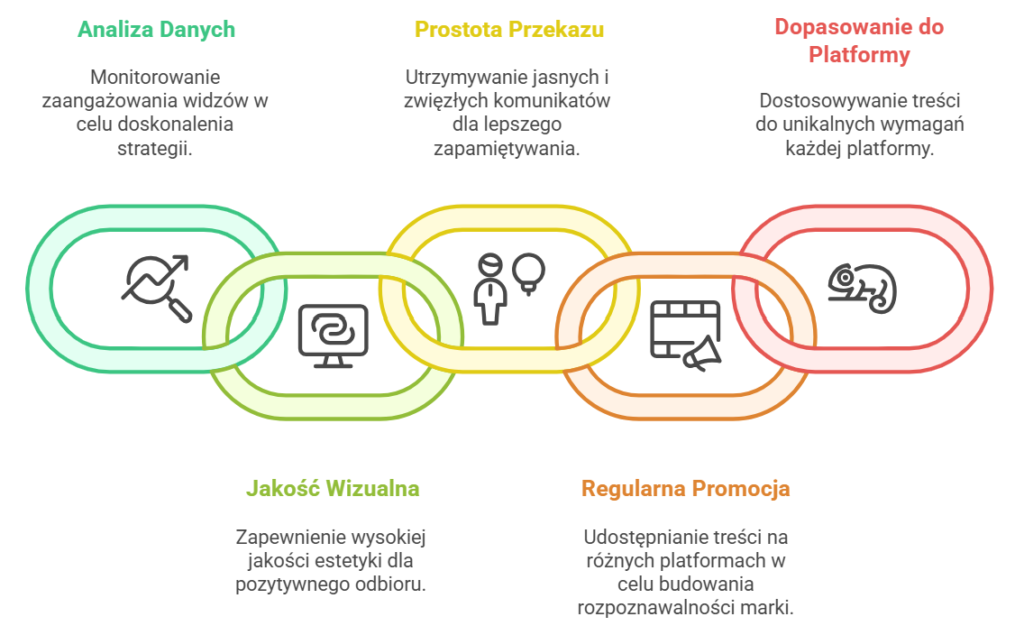
Each of these elements plays an important role in building a successful video campaign. By putting them into practice, you can not only capture your audience’s attention, but also achieve lasting results in content marketing.
Summary
Video content marketing is an effective tool for building brand recognition, increasing engagement and supporting sales through engaging video content tailored to your audience. Through a variety of formats – from tutorials and reviews to unboxings and live broadcasts – brands can reach users at different stages of the sales funnel. It is important to select the right channels (YouTube, TikTok, Instagram), have a consistent publishing strategy and measure results (including engagement rates, conversions, viewing time). Implementing video marketing requires defining goals, knowing the target audience, planning content production and distribution, and optimization based on analytics. Regular activities in this area translate into greater brand trust, better online visibility and a higher return on investment.
Was the article helpful?
Rate our article, it means a lot to us!
Let's talk!
Specjalistka od mediów społecznościowych z kilkuletnim doświadczeniem. Na co dzień zajmuje się tworzeniem angażujących treści, budowaniem strategii komunikacji i analizą wyników działań w social mediach. Zafascynowana możliwościami marketingu cyfrowego, chętnie eksploruje nowe trendy i narzędzia, by skutecznie wspierać rozwój marek.